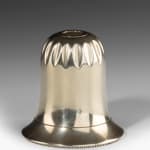Paktong Travelling Communion Chalice
4 x 2 ¼ in
Further images
With a faceted, knopped stem and simulated impressed fluting, on a foot with a knurled edge. The bowl and stem screw together, the bowl concealing the stem during transportation.
Paktong is a zinc, copper and nickel alloy resembling silver which was imported from China in the 18th and early 19th centuries. This chalice is modelled on contemporary drinking glasses and the form is one which is common in Scottish communion chalices of the period.
The Act against the Conventicles (meaning ‘assemblies’) of 1664 prohibited religious gatherings of more than five non-Anglicans and those breaking the law could be fined. This Act, combined with the conflicts arising from the fragmentation of the church in Scotland during the 18th century, meant that services there were conducted in the open; worshippers brought their own travelling chalices to these gatherings. (See British History Online, Charles II, 1670: An Act to prevent and suppress Seditious Conventicles. pages 648-651).








